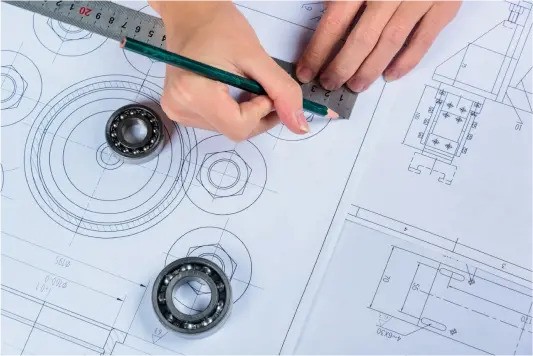Understanding Tolerances: Why They Matter in CNC Machined Parts
In the world of precision manufacturing, CNC Machined Parts stand at the center of countless industries—from aerospace and automotive to medical devices, robotics, and consumer electronics. These components often need to fit, move, withstand loads, or interact with other parts in highly controlled ways. This is where tolerances come into play.
Tolerances are not just numbers on engineering drawings; they define the difference between a part that functions perfectly and one that fails. Understanding tolerances is fundamental for engineers, machinists, designers, and anyone involved in manufacturing.
This article explores what tolerances are, why they matter, how they’re determined, and the effect they have on CNC Machined Parts.
What Are Tolerances?
Tolerances are the permissible variations in a physical dimension of a manufactured part. Because no manufacturing process is perfect, tolerances specify how much deviation from the “ideal” dimension is acceptable while still maintaining proper function.
For example, if a shaft is designed to be 10.00 mm, the drawing may specify a tolerance of ±0.02 mm, meaning the acceptable size ranges from 9.98 mm to 10.02 mm.
Tolerances ensure that CNC Machined Parts can be produced consistently, assembled correctly, and function safely.
Why Tolerances Are Essential in CNC Machined Parts
1. Ensuring Functional Fit
Many CNC Machined Parts must fit together precisely—think of bearings, gears, housings, or sliding mechanisms.
A difference as small as 0.05 mm can determine:
- whether two parts slide smoothly or get stuck,
- whether a seal prevents leakage,
- or whether a component vibrates or operates quietly.
Tight tolerances protect functional integrity, preventing mechanical issues that could lead to failure.
- Maintaining Product Reliability and Safety
In industries like aerospace or medical devices, certain CNC Machined Parts cannot fail—ever.
Tolerances ensure each machined component behaves exactly as expected under stress, temperature changes, and operational loads.
A part produced outside of its specified tolerance may:
- fail prematurely,
- compromise safety,
- cause system-wide malfunctions.
Correct tolerances are a key contributor to reliability and long-term performance.
- Reducing Manufacturing Errors
When tolerances are clearly defined, machinists know precisely what accuracy is required. This minimizes:
- rework
- scrap
- production delays
High-precision tolerances require specialized machines and processes, while looser tolerances allow faster and more economical production. Clear documentation means fewer surprises during machining.
- Ensuring Interchangeability
Manufacturers often need sets of CNC Machined Parts to be interchangeable, especially in mass production.
Tolerances guarantee that one component can be swapped for another without issues, regardless of when or where it was made.
This is essential in:
- assembly lines
- spare parts manufacturing
- modular product design
- Controlling Manufacturing Costs
One of the most overlooked aspects of tolerances is cost.
The tighter the tolerance, the more expensive the part becomes.
For example:
- ±0.1 mm tolerance may be quick and inexpensive to produce
- ±0.01 mm tolerance may require advanced tooling, slower machining, and extensive inspection
Understanding tolerances helps manufacturers strike the balance between cost and performance.
Types of Tolerances Used in CNC Machining
Different tolerances describe different types of variation. The most common include:
1. Dimensional Tolerances
These apply to linear sizes (length, width, diameter). They specify how much a dimension can vary from nominal design.
2. Geometric Dimensioning and Tolerancing (GD&T)
GD&T defines tolerances for geometry-related characteristics such as:
- flatness
- roundness
- perpendicularity
- position
- concentricity
These tolerances ensure that CNC Machined Parts perform correctly even when the shape—not just the size—is critical.
3. Surface Finish Tolerances
Surface roughness affects:
- wear
- friction
- sealing performance
Some components require mirror-smooth finishes; others function fine with a rougher texture.
How Tolerances Affect the Cost of CNC Machined Parts
Tolerances play one of the largest roles in determining manufacturing cost. This is because achieving high precision requires:
- better equipment
- slower machining speeds
- more frequent tool changes
- additional inspection steps
- skilled operators
Here’s a simple rule: The tighter the tolerance, the higher the cost.
Why?
- More accurate machines are needed
- More material may be removed slowly
- More measurements and inspections are required
- More scrap risk increases total cost
An experienced engineer knows how to specify tight tolerances only where absolutely necessary.
Balancing Tolerances and Performance
Not every part requires tight tolerances. Over-engineering is one of the most common causes of high manufacturing costs.
A smart design uses tight tolerances only on features that:
- affect fit
- influence performance
- ensure safety
- involve moving or interacting parts
Other features—such as non-critical surfaces—can use standard or loose tolerances to reduce machining time and cost.
The Role of CNC Machining Technology in Achieving Tolerances
Modern CNC machines are capable of extremely precise motion control. However, achieving tolerances depends on more than just the machine. It requires:
- stable and rigid machine construction
- high-quality cutting tools
- optimal toolpaths
- proper workholding
- controlled temperature and vibration
- skilled programmers and machinists
In sophisticated workshops, environmental factors like humidity or thermal expansion are managed to ensure the highest consistency in CNC Machined Parts.
Common Misconceptions About Tolerances
1. “Tighter tolerances are always better.”
Not true. Unnecessary precision increases cost without adding value.
2. “CNC machines automatically guarantee perfect accuracy.”
Machines help, but operator skill, setup, and process control still matter.
3. “Tolerance issues only affect complex parts.”
Even simple components can fail if tolerances are ignored.
How Engineers Choose the Right Tolerance
Choosing the proper tolerance involves evaluating:
- functional requirements
- safety needs
- manufacturing capability
- cost constraints
- assembly method
- material behavior
- potential wear over time
Engineers typically refer to:
- design guidelines
- industry standards
- past experience
- collaboration with machining specialists
This ensures that CNC Machined Parts meet their performance goals without unnecessary cost increases.
Consequences of Poor Tolerance Control
If tolerances are misunderstood or ignored, the consequences can be serious:
- parts may not assemble correctly
- excessive vibration or noise may occur
- mechanisms may bind or seize
- leaks or pressure loss may happen
- premature wear or failure may result
- safety hazards may emerge
- entire production runs may be rejected
Tolerances protect both the manufacturer and the end user.
The Relationship Between Materials and Tolerances
Different materials behave differently under machining. For example:
- aluminum machines easily and maintains tight tolerances
- stainless steel can warp from heat
- plastics can expand or contract based on temperature
- titanium requires slow cutting to avoid tool wear
Choosing tolerances for CNC Machined Parts requires an understanding of how the chosen material behaves during machining and in its final application.
Future Trends: Tolerances and Advanced Manufacturing
With the rise of Industry 4.0, machines are becoming smarter and more automated. This leads to:
- higher precision
- real-time tolerance monitoring
- automated quality control
- improved repeatability
- reduced scrap rates
As technology evolves, achieving tight tolerances will become more efficient and more accessible.
Conclusion: Why Tolerances Matter More Than Ever
Tolerances are the silent heroes behind successful CNC Machined Parts. They ensure reliability, functionality, and consistency across industries where precision matters most. Understanding tolerances allows engineers and manufacturers to make smarter decisions that optimize performance while controlling cost.
Whether you’re designing a high-precision aerospace component or a simple structural bracket, tolerances determine the final outcome. Mastering them is essential for producing high-quality CNC Machined Parts that perform reliably throughout their service life.
If you work with CNC machining, mastering tolerances isn’t just beneficial—it’s necessary.


